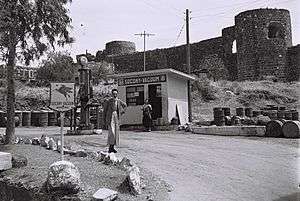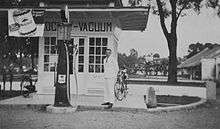Vacuum Oil Company
Vacuum Oil Company was an American oil company known for its Gargoyle 600-W Steam Cylinder Oil. Vacuum Oil merged with the Standard Oil Co of New York, commonly known as Socony Oil to form Socony-Vacuum Oil Company, and is now a part of ExxonMobil.

History
Vacuum Oil was founded in 1866 by Matthew Ewing and Hiram Bond Everest, of Rochester, New York. Lubrication oil was an accidental discovery while attempting to distil kerosene. Everest noted the residue from the extraction was suitable as a lubricant. Soon after, the product became popular for use in steam engines and internal-combustion engines. Ewing sold his interest to Everest, who carried on the company.[1] Vacuum was bought by Standard Oil in 1879.
It originated the Mobil trademark in 1899 (as "Mobilgas;" "Mobiloil" came later). When Standard Oil was broken up in 1911 due to the Sherman Antitrust Act, Vacuum became an independent company again.[2]

Vacuum Oil and Standard Oil of New York (Socony) merged in 1931, after the government gave up attempts to prevent it. The newly-combined entity, Socony-Vacuum Corp, was the world's third-largest oil company.[3]
During World War II, the Tschechowitz I & II subcamps of Auschwitz in Czechowice-Dziedzice provided forced labor for Vacuum Oil Company facilities in Poland which were captured and operated by Nazi Germany.[4]
In 1955, the company became Socony Mobil Oil Company.[5] In 1966, it was renamed Mobil Oil Corporation, later shortened to Mobil Corporation. [6]
Legal challenges
In 1887, founder Hiram Bond Everest and son Charles M. Everest were charged with conspiracy to destroy competitor Buffalo Lubricating Oil Co. It was alleged that, having sold a three-quarter interest in their company to Standard Oil, they were attempting to destroy their rival's refinery, preventing it from manufacturing petroleum products, and from acquiring Vacuum's skilled employees. One employee who had left Vacuum to work for Buffalo was Albert A. Miller, who was bribed to sabotage the new company's plant, causing an explosion. Hiram and Charles Everest were both found guilty, but there was insufficient evidence to prove the allegation that the Everests had acted under instructions from Standard Oil.[7]
In 1907, Vacuum Oil, Standard Oil, New York Central Railroad, and Pennsylvania Railroad were all indicted for violations in Inter-State Commerce laws. Vacuum Oil was charged with shipping 228 cars of petroleum and petroleum products to Standard Oil at unlawful rates, via the New York Central and Pennsylvania railroads.[8]
References
| Wikimedia Commons has media related to Vacuum Oil Company. |
- "Vacuum Standardized". Time Magazine, 1930. 1930-03-03. Retrieved 2009-12-01.
- Marius Vassiliou (2018). Historical Dictionary of the Petroleum Industry, 2nd Ed. Lanham, MD: Rowman and Littlefield. ISBN 1538111594 ISBN 978-1-5381-1159-8.
- "Business & Finance: Socony-Vacuum Corp". Time Magazine, 1931. 1931-08-10. Retrieved 2009-12-01.
- "Sub-Camps of Auschwitz Concentration Camp". Auschwitz-Birkenau: Memorial and Museum. auschwitz.org.pl. Archived from the original on 2009-06-02. Retrieved 2009-05-21.
- Vacuum Oil Co Ltd Railway Gazette December 23, 1955 page 554
- "SOCONY DROPPED FROM MOBIL NAME; Stockholders Also Approve an Increase in Shares". The New York TImes. May 18, 1966. Retrieved 2019-09-16.
- "The Everests Convicted" (PDF). New York Times, 1887. 1887-05-16. Retrieved 2009-12-01.
- "Standard Indicted By New York Jury" (PDF). New York Times, 1907. 1907-08-10. Retrieved 2009-12-01.